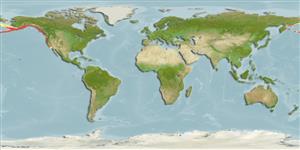Teleostei (teleosts) >
Perciformes/Scorpaenoidei (Scorpionfishes) >
Sebastidae (Rockfishes, rockcods and thornyheads) > Sebastinae
Etymology: Sebastes: Greek, sebastes = august, venerable (Ref. 45335).
Eponymy: Frank Cramer (1861–1948) was an ichthyologist and biologist at Stanford University. [...] (Ref. 128868), visit book page.
More on author: Jordan.
Environment: milieu / climate zone / depth range / distribution range
Ecology
Marine; bathydemersal; depth range 25 - 600 m (Ref. 6793), usually 76 - ? m (Ref. 2850). Temperate; 70°N - 32°N, 162°E - 116°W
Northeast Pacific: southeast of Zhemchug Canyon in the Bering Sea to Santa Catalina Island, California, USA.
Length at first maturity / Size / Weight / Age
Maturity: Lm 34.2, range 24 - ? cm
Max length : 58.0 cm TL male/unsexed; (Ref. 27437); max. reported age: 105 years (Ref. 55644)
Dorsal spines (total): 13; Dorsal soft rays (total): 12 - 14; Anal spines: 3; Anal soft rays: 5 - 7. Head spines strong to moderate - nasal, preocular, supraocular, postocular, tympanic, parietal and nuchal spines present, coronal spines absent; second anal fin spine shorter than third (Ref. 27437). Caudal fin moderately indented (Ref. 6885). Deep bodied, pinkish with 4 or 5 dark patches on back, 3 under spinous dorsal, 1 under caudal peduncle (Ref. 27437).
A deep-water species found on soft bottoms (Ref. 2850). Viviparous (Ref. 34817). Anterolateral glandular grooves with venom gland (Ref. 57406).
Allen, M.J. and G.B. Smith, 1988. Atlas and zoogeography of common fishes in the Bering Sea and northeastern Pacific. NOAA Tech. Rep. NMFS 66, 151 p. (Ref. 6793)
IUCN Red List Status (Ref. 130435: Version 2024-1)
Human uses
Fisheries: commercial; gamefish: yes
Tools
Special reports
Download XML
Internet sources
Estimates based on models
Preferred temperature (Ref.
123201): 1 - 7.5, mean 4.7 °C (based on 336 cells).
Phylogenetic diversity index (Ref.
82804): PD
50 = 0.5000 [Uniqueness, from 0.5 = low to 2.0 = high].
Bayesian length-weight: a=0.01000 (0.00495 - 0.02022), b=3.09 (2.92 - 3.26), in cm total length, based on LWR estimates for this Genus-body shape (Ref.
93245).
Trophic level (Ref.
69278): 3.8 ±0.5 se; based on size and trophs of closest relatives
Resilience (Ref.
120179): Very Low, minimum population doubling time more than 14 years (K=0.09(?); tm=5.1-8.4; tmax=105; Fec=19,815).
Prior r = 0.09, 95% CL = 0.06 - 0.14, Based on 2 full stock assessments.
Fishing Vulnerability (Ref.
59153): High vulnerability (64 of 100).
Nutrients (Ref.
124155): Calcium = 19 [8, 60] mg/100g; Iron = 0.229 [0.097, 0.540] mg/100g; Protein = 17.9 [16.7, 19.0] %; Omega3 = 1.23 [0.53, 2.97] g/100g; Selenium = 43.6 [17.2, 124.2] μg/100g; VitaminA = 24 [8, 78] μg/100g; Zinc = 0.378 [0.200, 0.665] mg/100g (wet weight);
